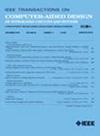Optimized Modular Adder Architecture for Cryptographic Applications on FPGAs
IF 2.9
3区 计算机科学
Q2 COMPUTER SCIENCE, HARDWARE & ARCHITECTURE
IEEE Transactions on Computer-Aided Design of Integrated Circuits and Systems
Pub Date : 2024-12-16
DOI:10.1109/TCAD.2024.3518412
引用次数: 0
Abstract
Modular addition is a fundamental operation in public-key cryptographic algorithms operating in finite fields, such as elliptic curve cryptography (ECC), Chebyshev polynomials, and post-quantum cryptography (PQC). The performance of these cryptographic algorithms is limited by the conventional modular adder approach, which incorporates two cascaded adders in series. This approach leads to a doubled critical path delay, ultimately causing a decrease in frequency despite utilizing a high-performance adder. This research presents a high-performance, low-area architecture for a modular adder, employing a novel approach. Specifically designed for various prime fields recommended in public key cryptography, the architecture optimally utilizes the carry chain and exploits the structural advantages of the 7-series field programmable gate array and series beyond. Implementation results demonstrate superior performance, achieving operating frequencies of 290.0 MHz for 192 bits and 205.5 MHz for 1024 bits. Notably, the proposed design performs modular addition in a single clock cycle, resulting in an approximate 57% frequency enhancement compared to the conventional approach. Consequently, this architecture stands as an optimal solution for systems demanding high-speed operations.fpga上加密应用的优化模块化加法器架构
模加法是有限域公钥密码算法中的基本运算,如椭圆曲线密码(ECC)、切比雪夫多项式和后量子密码(PQC)。这些加密算法的性能受到传统的模块化加法器方法的限制,它包含两个串联的级联加法器。这种方法导致双倍的关键路径延迟,最终导致频率降低,尽管使用高性能加法器。本研究提出了一种高性能、低面积的模块化加法器架构,采用了一种新颖的方法。该架构专为公钥密码学中推荐的各种素数域而设计,最佳地利用了进位链,并利用了7系列现场可编程门阵列和其他系列的结构优势。实现结果显示了优异的性能,实现了192位290.0 MHz和1024位205.5 MHz的工作频率。值得注意的是,所提出的设计在单个时钟周期内执行模块化加法,与传统方法相比,频率提高了约57%。因此,这种架构是要求高速运行的系统的最佳解决方案。
本文章由计算机程序翻译,如有差异,请以英文原文为准。
求助全文
约1分钟内获得全文
求助全文
来源期刊
CiteScore
5.60
自引率
13.80%
发文量
500
审稿时长
7 months
期刊介绍:
The purpose of this Transactions is to publish papers of interest to individuals in the area of computer-aided design of integrated circuits and systems composed of analog, digital, mixed-signal, optical, or microwave components. The aids include methods, models, algorithms, and man-machine interfaces for system-level, physical and logical design including: planning, synthesis, partitioning, modeling, simulation, layout, verification, testing, hardware-software co-design and documentation of integrated circuit and system designs of all complexities. Design tools and techniques for evaluating and designing integrated circuits and systems for metrics such as performance, power, reliability, testability, and security are a focus.

 求助内容:
求助内容: 应助结果提醒方式:
应助结果提醒方式:


